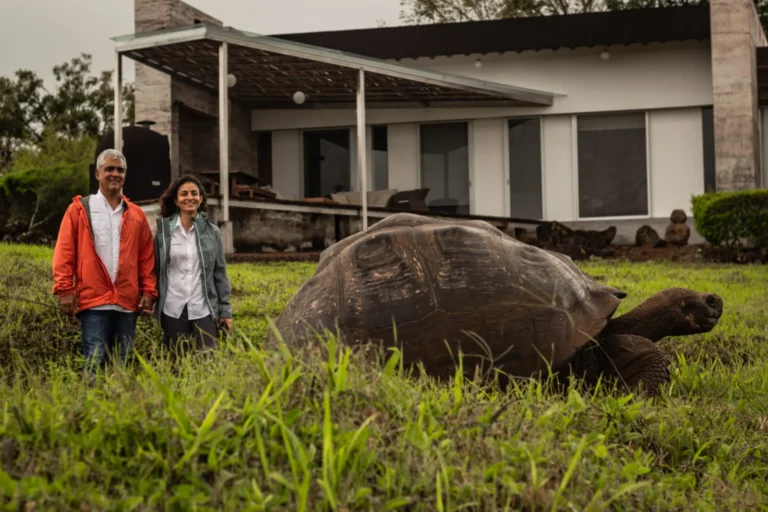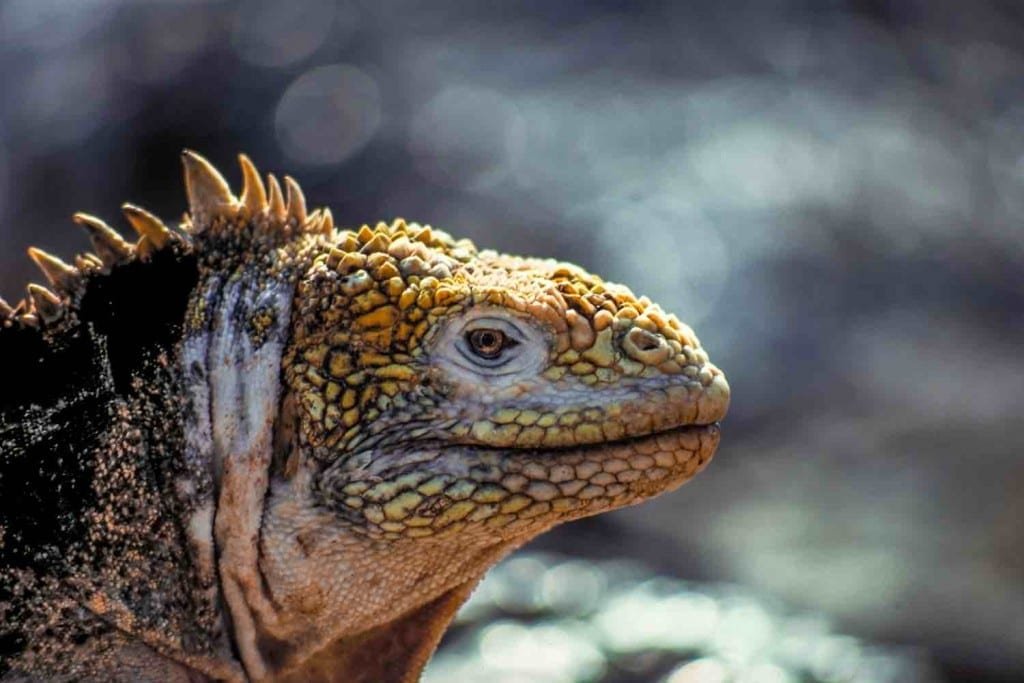
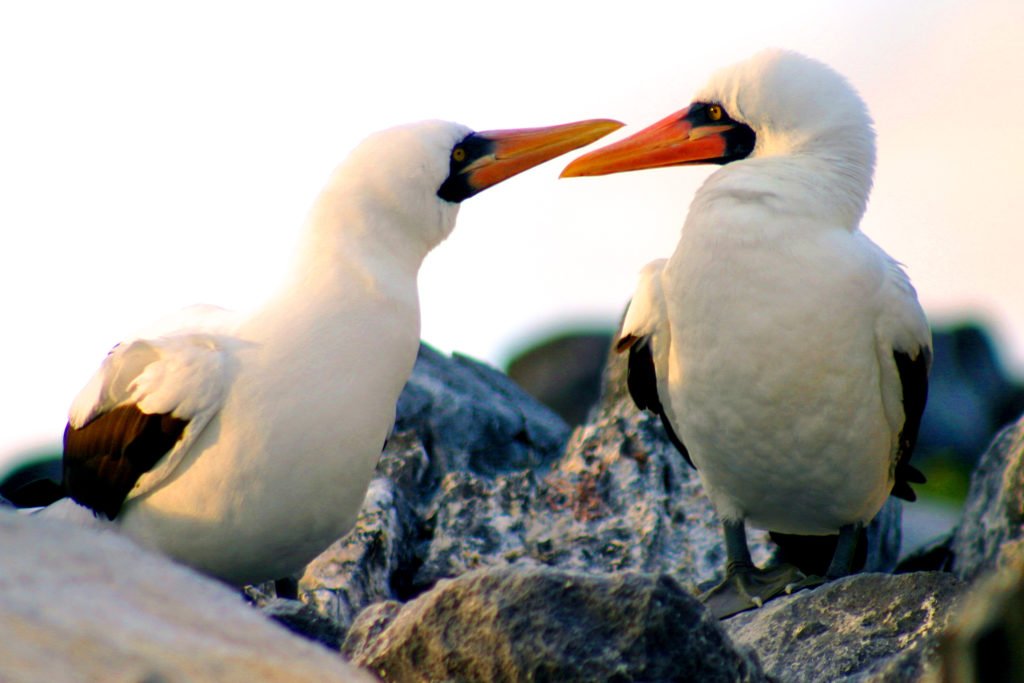
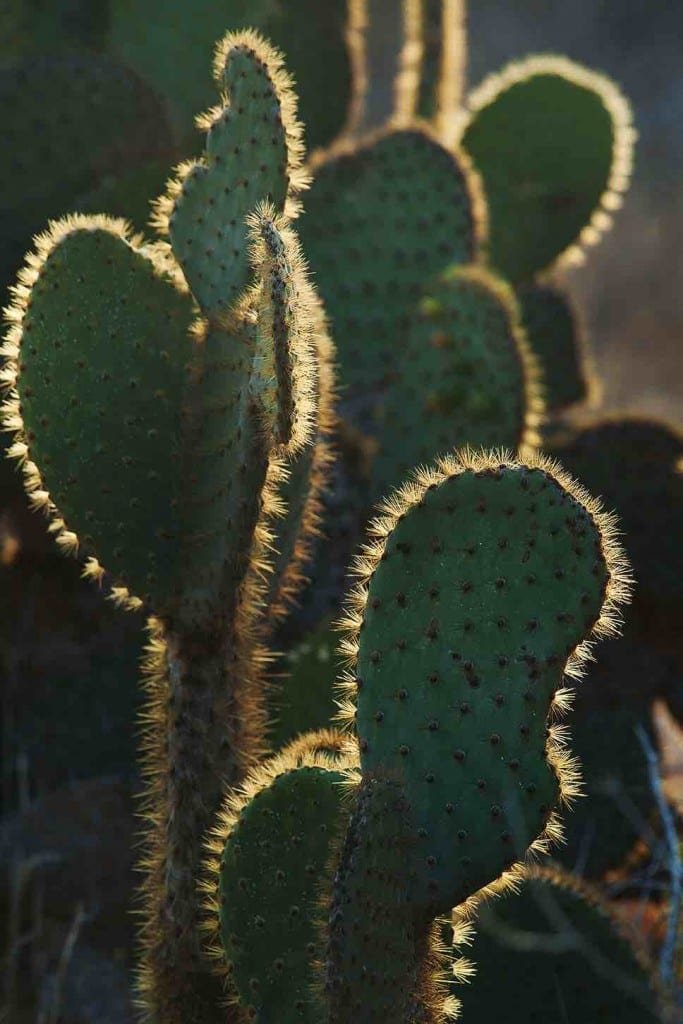
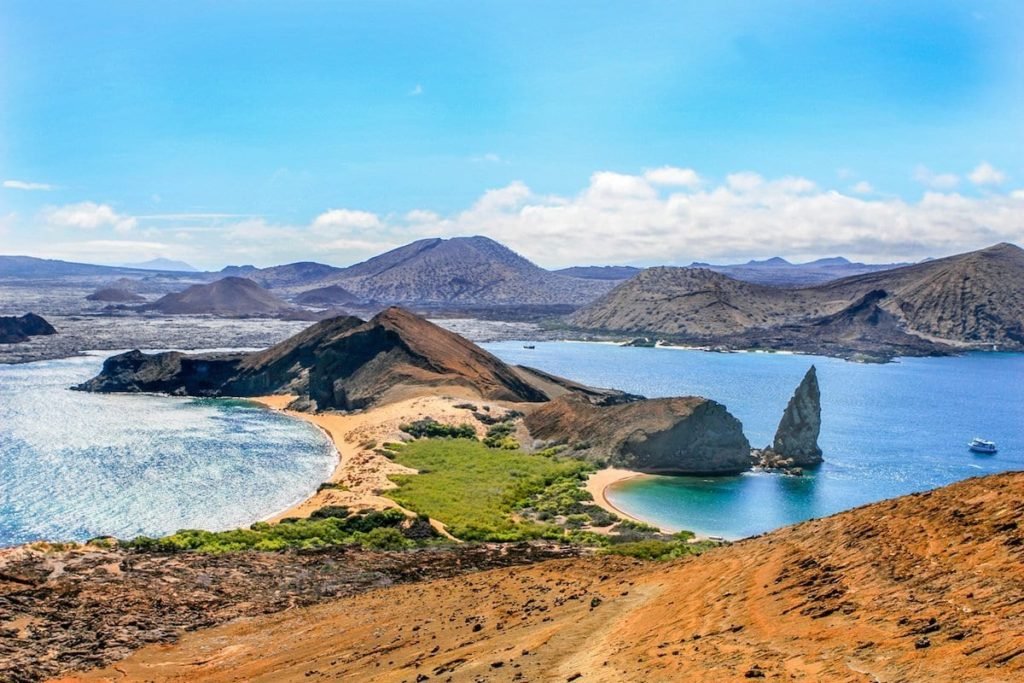
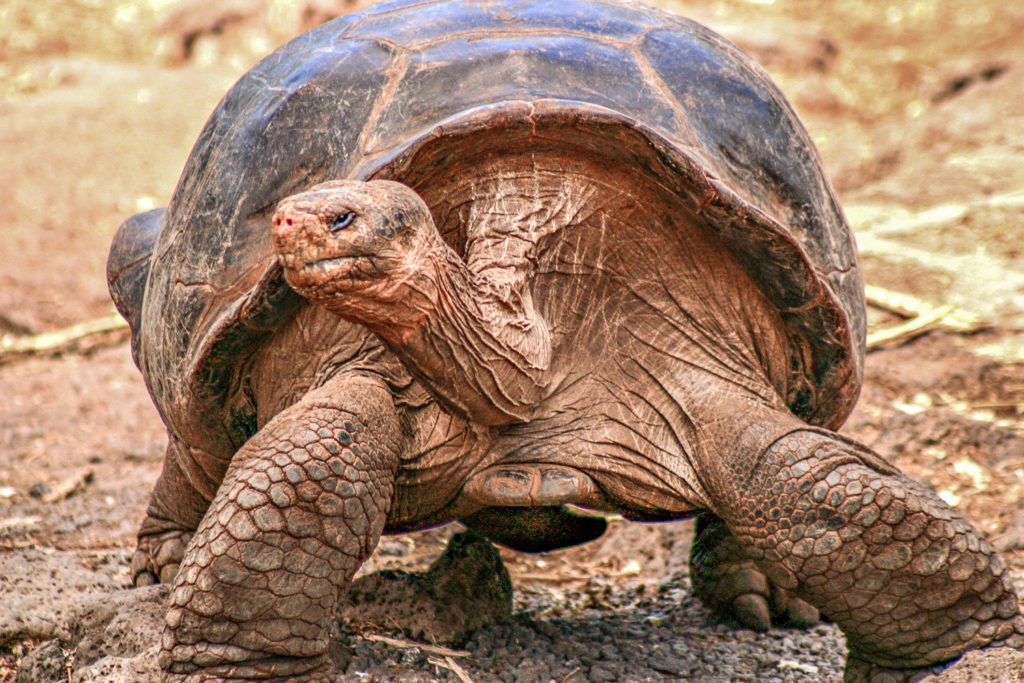
The Galapagos Islands
The Galapagos Archipelago consists of thirteen main islands, six minor islands, and scores exposed islets and rocks. Each offers different opportunities for visitors. Most have abundant bird life. Some are known for their strange volcanic features and plant varieties. Yet another group is famous for reptiles and sea mammals.
Like the archipelago itself (also known as the “Enchanted Isles” or the Encantadas), most of the individual islands of the Galapagos have multiple names, acquired from years of successive control.
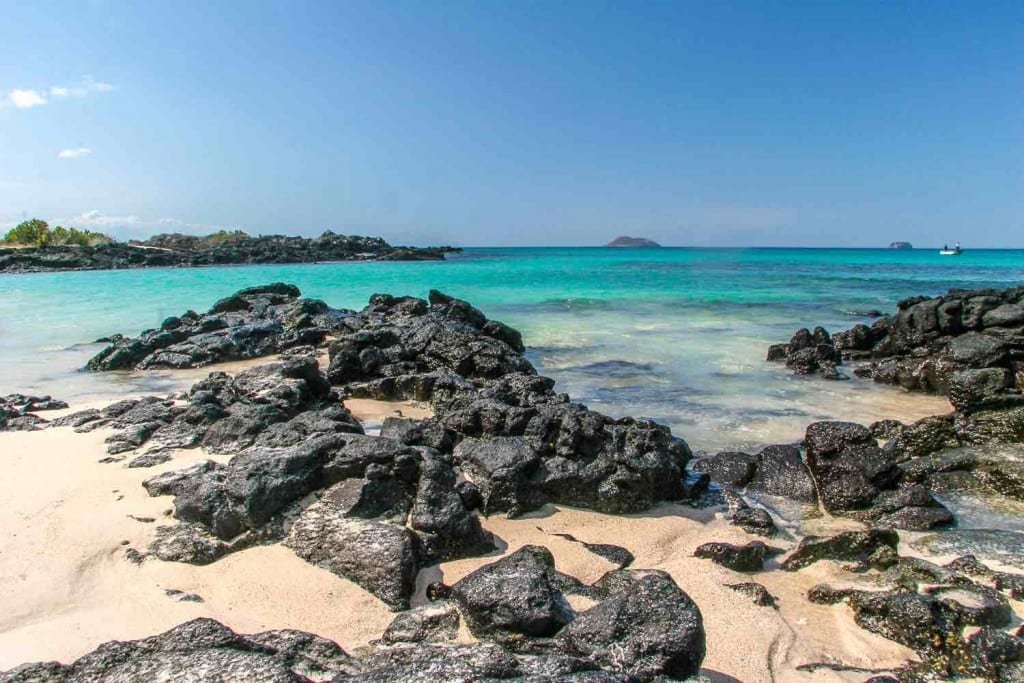
Baltra (South Seymour)
Baltra (South Seymour) is home to the Galapagos Ecological Airport (airport code GPS). In recent history, South Seymour Island was also used as a military base. South Seymour’s pier is a five-minute drive from the air terminal. Dry, with scrubby vegetation. Baltra is located a short distance north of Santa Cruz.
Bartolome (Bartholomew)
Bartolome is a small island located just off the eastern side of Santiago. Bartholomew is famous for iconic conical formation—Pinnacle Rock—around which penguins and sea lions can be observed.
Notably, Bartolome Island has a wooden staircase leading to its summit and two sandy beaches good for swimming.
Species found in Bartolome:
On land:
- Galápagos lava lizards (endemic) – small reptiles adapted to the island’s volcanic terrain.
- Sally Lightfoot crabs – not endemic but abundant along the shoreline.
In the water:
- Galápagos penguins (endemic) – the only penguin species living north of the equator, often seen swimming near Pinnacle Rock.
- Green sea turtles – native to the region but not endemic.
- White-tipped reef sharks – common throughout the archipelago.
- Tropical reef fish such as parrotfish and angelfish – mostly native but not endemic.
- Marine rays and reef sharks – native species.
Birdlife:
- Brown pelicans – native but not endemic.
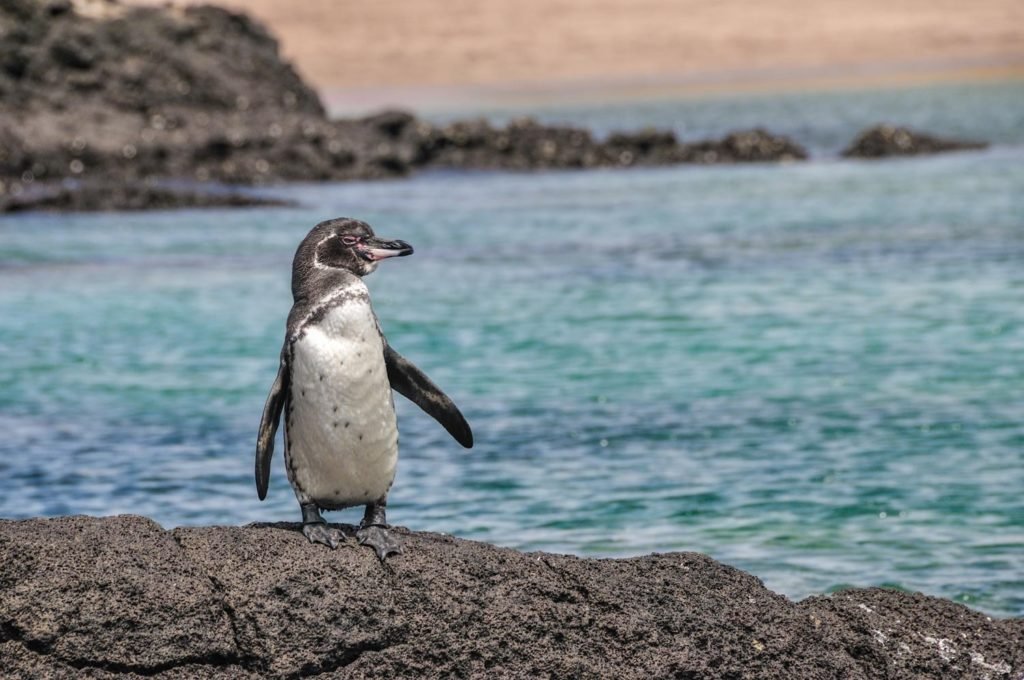
Darwin
Darwin (Culpepper) is one of the most remote and wildlife-rich islands in the Galápagos, located at the far northwest of the archipelago. This small island is home to various seabirds, but its main attraction is its sea life. The island is small, rugged, and closed to land visits.
Divers come to Darwin Island to witness huge schools of hammerhead sharks, a rare sight in the central cluster of islands. The underwater ecosystem around Darwin and nearby Wolf Island is considered one of the most biodiverse shark habitats on Earth.
Species found in Darwin:
In the water:
- Whale sharks – especially numerous from June to November; most are pregnant females.
- Scalloped hammerhead sharks (endemic subspecies) – seen in large, mesmerizing schools.
- Galápagos sharks (endemic) – medium-sized reef sharks unique to the region.
- Silky sharks – native but not endemic.
- Manta rays, eagle rays, and mobula rays – native pelagic species.
- Green sea turtles – native to the region.
- Tuna, barracuda, and jacks – common pelagic fish species.
- Bottlenose dolphins – frequently seen around the island, not endemic.
- Orcas – occasional visitors, native but not endemic.
Birdlife:
- Darwin’s finches (endemic group) – small passerines that evolved into multiple distinct species across the archipelago.
- Nazca boobies (endemic subspecies) – large seabirds that nest on cliffs and rocky ledges.
- Red-footed boobies – widespread across the Pacific, not endemic.
- Swallow-tailed gulls (endemic) – the world’s only fully nocturnal gull.
- Frigatebirds – both magnificent and great frigatebirds, native but not endemic.
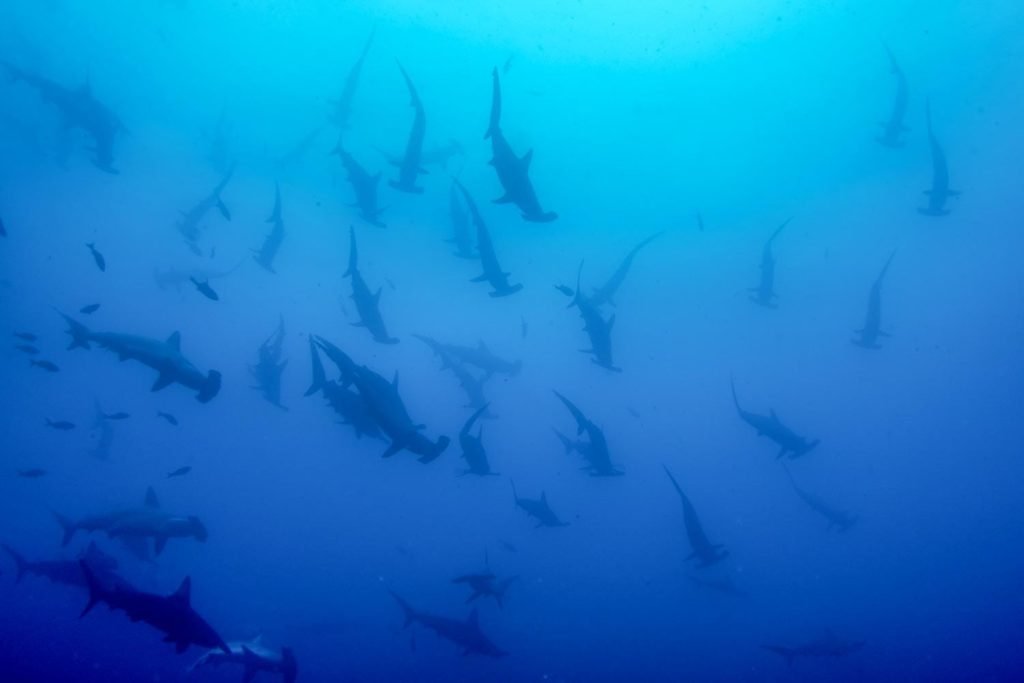
Española
Española (Hood) is the large southeastern-most island in the Galapagos, as well as the oldest, estimated to be about four million years old. Because it is so far away from the other islands, it has the most endemic species.
Española features three main stops: Gardner Bay, Punta Suarez, and Osborn Islet.
Gardner Bay offers a long, white, sandy beach, where colonies of sea lions laze in the sun. This is an excellent place to swim with these friendly mammals.
Punta Suarez features the largest variety of marine iguanas in the Galapagos, as well as masked boobies and blue-footed boobies nesting along the cliff’s edge. The famous waved albatross also nests here. From April to November, Espanola is one of the best places to witness waved albatross mating rituals. Hood Island also has a famous blowhole called “Punta Suarez Blowhole”, where seawater shoots through a natural lava tunnel, creating impressive spouts during high tide.
Osborn Islet is a small island where you will have the opportunity to kayak and snorkel.
Species found in Española:
On land:
- Lava lizards (endemic) – small reptiles found across the rocky terrain.
- Galápagos sea lions (endemic subspecies) – frequently resting on beaches and rocks.
- Opuntia cacti – native vegetation supporting local wildlife.
In the water:
- Green sea turtles – native but not endemic.
- White-tipped reef sharks – native but not endemic.
- Manta rays – native pelagic species.
- Marine fish – including parrotfish, surgeonfish, and wrasses, mostly native.
- Bottlenose dolphins – not endemic.
- Orcas – occasional visitors, native but not endemic.
Birdlife:
- Waved albatrosses (endemic to Española) – largest seabirds in the Galápagos, breed almost exclusively on Española from April to December.
- Nazca boobies (endemic subspecies) – nesting on cliffs and ledges.
- Red-footed boobies – nest along the coast, not endemic.
- Swallow-tailed gulls (endemic) – found on cliffs and coastal rocks.
- Darwin’s finches (endemic group) – a few species present in vegetated areas.
- Galápagos mockingbirds (endemic subspecies) – found inland, adapted to dry scrub.

Fernandina
Fernandina (Narborough) is a large island found just west of Isabela. Geologically speaking, Fernandina is the newest island in the Galapagos. The primary landing point for this island is Punta Espinoza, where visitors can walk among hundreds of marine iguanas on black lava rocks. This island is also home to the active La Cumbre volcano, which last erupted in March 2024.
Species found in Fernandina:
On land:
- Galápagos flightless cormorants (endemic) – the only cormorant in the world that cannot fly, found along rocky shores.
- Lava lizards (endemic) – small reptiles adapted to the island’s volcanic terrain.
- Galápagos penguins (endemic) – rarely come ashore, mostly seen along rocky coastal areas.
- Galápagos marine iguanas (endemic) – black iguanas basking on volcanic rocks.
- Galápagos sea lions (endemic subspecies) – resting along beaches and rocky outcrops.
In the water:
- Galápagos sharks (endemic) – common around the island’s reefs.
- Whale sharks – occasional sightings during the warmer months.
- Ocean sunfish – locally know as Mola Mola. Occasional sightings.
- Manta rays – native pelagic species.
- Marine fish – including parrotfish, angelfish, and surgeonfish, mostly native.
- Sea turtles – native, occasionally spotted while snorkeling.
- Flightless cormorants (endemic) – the only truly flightless cormorant species in the world.
- Galápagos penguins (endemic) – seen along the rocky shores.
Birdlife:
- Swallow-tailed gulls (endemic) – nesting on coastal cliffs.
- Darwin’s finches (endemic group) – a few species present in sparse vegetation.
- Great and magnificent frigatebirds – native but not endemic.
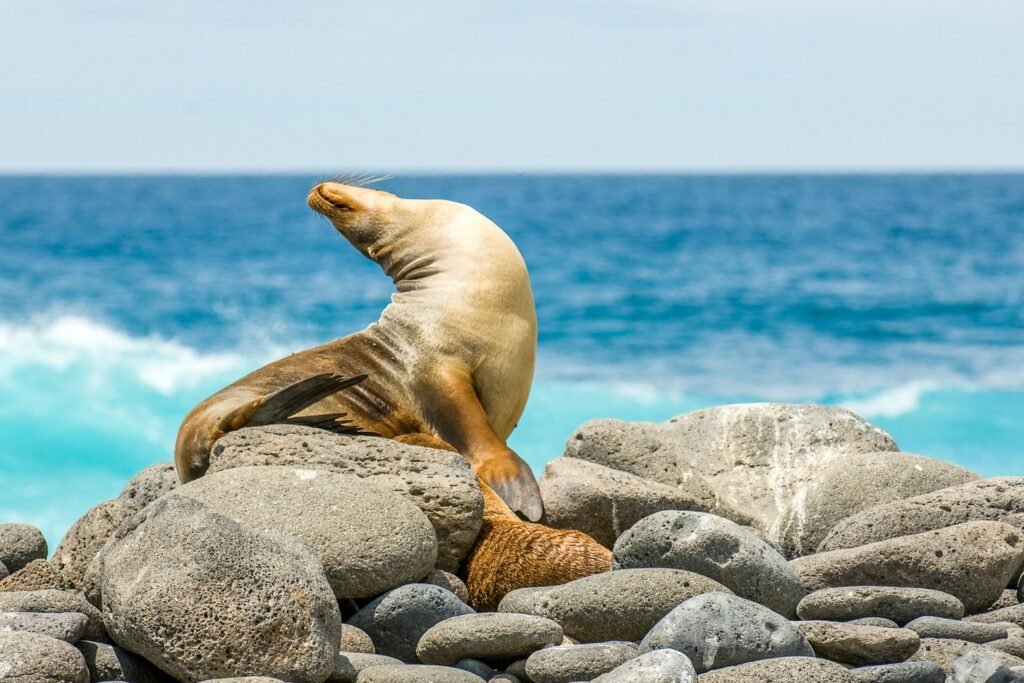
Floreana
Floreana (Santa Maria or Charles) is a large island due south of Santa Cruz. Floreana Island has a colorful history, including pirates, whalers, convicts, and a small band of peculiar colonists. The island has three major sites: Baroness Observatory, Post Office Bay, and Punta Cormorant.
The Baroness’ Observatory offers views of La Loberia and the volcanic features of Floreana Island. Post Office Bay, located on the island’s north side, is the site of the do-it-yourself mail barrel set up by 18th-century whalers. Here you will also find El Mirador, one of the newest sites accessible to visitors. Punta Cormorant features green and red beaches. Here, the saltwater lagoons are home to flamingos, pintails, stilts, and other wading birds.
Floreana Island also has a white sand beach where sea turtles nest from December to May. Some of the best snorkeling areas in the Galapagos are the Devil’s Crown and Champion islets.
Species found in Floreana:
On land:
- Galápagos sea lions (endemic subspecies) – commonly seen along beaches and rocky shores.
- Lava lizards (endemic) – small reptiles found across the island’s volcanic terrain.
- Opuntia cacti – native vegetation supporting local wildlife.
- Giant tortoises (Floreana subspecies, Chelonoidis niger/floreanae, historically extinct in the wild, but reintroduction efforts ongoing)
In the water:
- Green sea turtles – native but not endemic.
- White-tipped reef sharks – native but not endemic.
- Hammer-head sharks – ocassionally sean during snorkeling or diving.
- Manta rays – native pelagic species.
- Marine fish – including parrotfish, angelfish, and surgeonfish, mostly native.
- Sea lions – also often seen while snorkeling.
Birdlife:
- Floreana mockingbirds (endemic subspecies) – very rare, limited sightings in certain areas.
- Galápagos penguins (endemic) – occasionally seen on rocky coastal sites.
- Nazca boobies (endemic subspecies) – nesting along cliffs.
- Red-footed boobies – native but not endemic.
- Swallow-tailed gulls (endemic) – coastal cliffs.
- Darwin’s finches (endemic group) – several species in vegetated areas.
- Great and magnificent frigatebirds – native but not endemic.
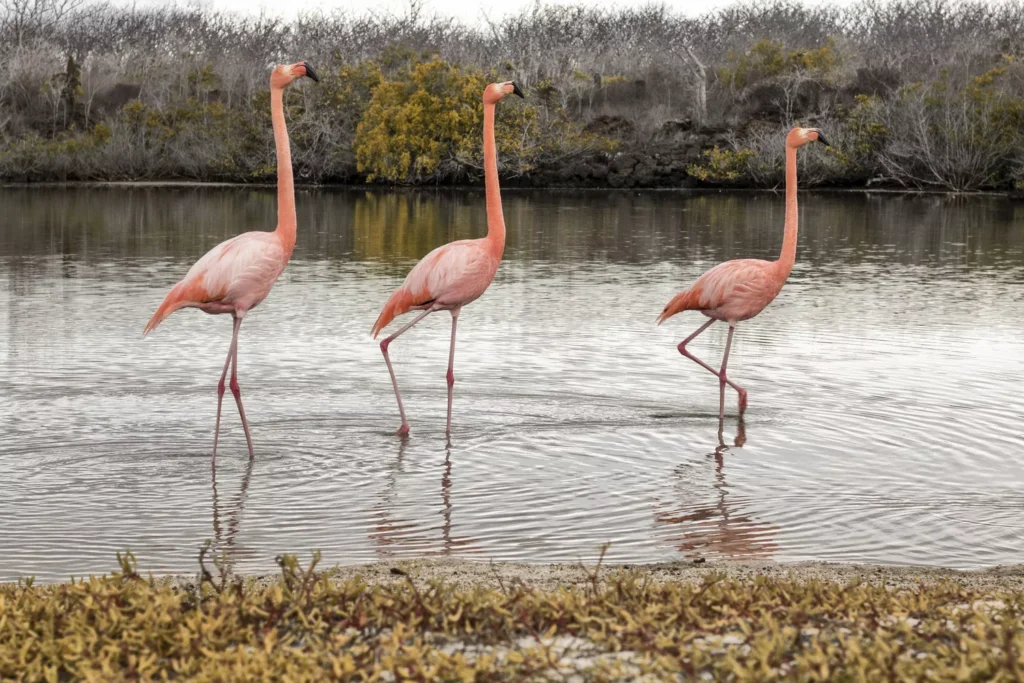
Genovesa
Genovesa (Tower) is a small island, located about 45 miles north-northeast of Santa Cruz and approximately 25 miles due east of Marchena. Genovesa is sometimes referred to as “Birder’s Island”, named for its abundance of Frigates, Red-footed boobies, Nazca boobies, Noddy terns, tropic birds, doves, Storm-petrels, and Darwin finches. The island’s two visitor sites are Darwin Bay and El Barranco.
Darwin Bay, encompassing the island’s southern side, was formed by a collapsed volcano. The site features a white-sand coral beach, which includes a half-mile trail that winds through mangroves filled with land birds.
El Barranco is also known as ‘Prince Philip’s Steps’, named after a visit by the British Monarch in 1964. At El Barranco, a steep, rocky path leads up to a high cliff rock face offering great views. This site is also home to Palo Santo vegetation as well as red-footed boobies, short-eared owls, Galapagos storm petrels, and Galapagos doves.
Species found in Genovesa:
On land:
- Lava lizards (endemic) – found across the rocky terrain.
- Galápagos sea lions (endemic subspecies) – resting along beaches and coastal rocks.
- Opuntia cacti – native vegetation supporting wildlife.
In the water:
- Green sea turtles – native but not endemic.
- White-tipped reef sharks – native but not endemic.
- Hammerhead sharks – native but not endemic.
- Galapagos sharks (endemic)
- White-tip reef sharks – native but not endemic.
- Manta rays – native pelagic species.
- Marine fish – including parrotfish, angelfish, and surgeonfish, mostly native.
- Sea lions – often seen swimming near the shore.
Birdlife:
- Red-footed boobies – nesting in cactus forests, native but not endemic.
- Nazca boobies (endemic subspecies) – abundant on cliffs.
- Swallow-tailed gulls (endemic) – nesting on cliffs.
- Red-billed tropicbirds – native but not endemic, often flying along cliff edges.
- Darwin’s finches (endemic group) – several species in scrubby areas.
- Galápagos mockingbirds (endemic subspecies) – present in vegetated zones.
- Great and magnificent frigatebirds – native but not endemic.
- Petrel (endemic) – critically endangered.
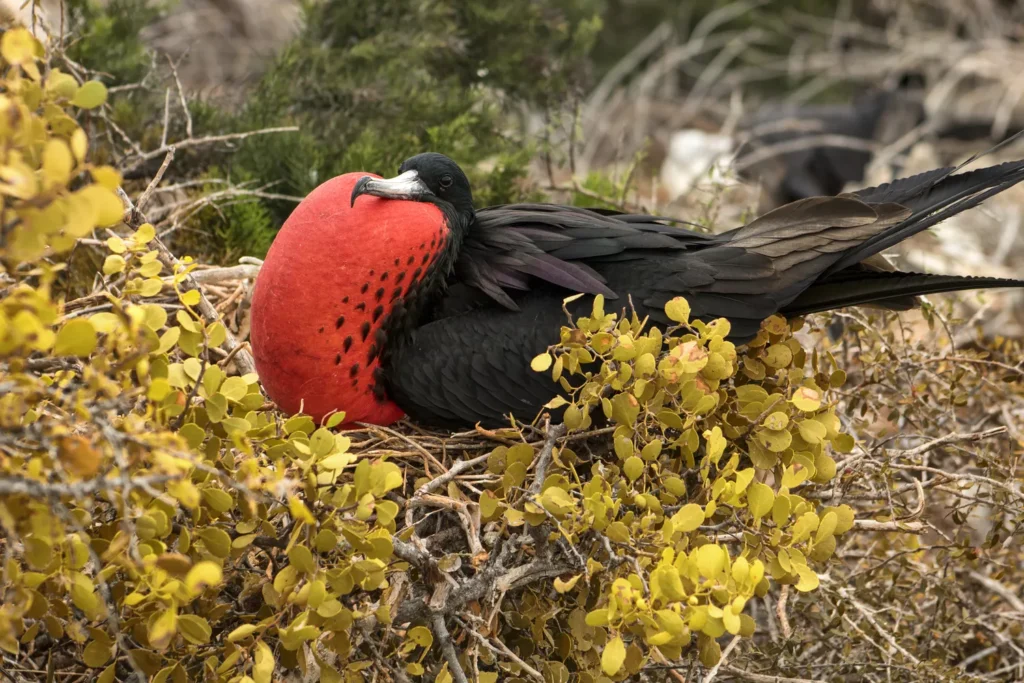
Isabela
Isabela (Albemarle) is the largest island in the group, formed by the merger of six volcanoes, and one of the Galapagos four inhabited islands. Isabela is widely visited, as evidenced by the port town on its southeastern shore (Puerto Villamil). Its landscapes are dramatic and diverse, from active volcanic cones and lava fields to wetlands, mangroves, and white-sand beaches. The island is a key destination for both land-based and marine exploration and features several visitor sites.
On the inhabited side of the island, visitors can explore laval tunnels and wetlands. Also, some of the most popular sites Tintoreras, Wall of Tears, and Sierra Negra. Cruises also make stops in Moreno Point, Elizabeth Bay, Urbina Bay, and Tagus Point.
Isabela is also home to the fames Centro de Crianza de Tortugas Gigantes which allows visitors to see land iguanas and giant tortoises year-round.
Species found in Isabela:
On land:
- Galápagos giant tortoises (endemic subspecies, e.g., Chelonoidis vandenburghi and others) – found in highland zones of different volcanoes.
- Galápagos marine iguanas (endemic) – often seen along rocky shores.
- Lava lizards (endemic) – small reptiles across volcanic terrain.
- Galápagos land iguanas (endemic) – primarily in drier lowland areas.
- Galápagos sea lions (endemic subspecies) – lounging on beaches and rocky coasts.
In the water:
- Galápagos sharks (endemic) – common around the island’s reefs.
- White-tipped reef sharks – native but not endemic.
- Manta rays – native pelagic species.
- Green sea turtles – native but not endemic.
- Marine fish – including parrotfish, angelfish, and surgeonfish, mostly native.
- Tuna, barracuda, and jacks – common pelagic species.
Birdlife:
- Darwin’s finches (endemic group) – multiple species across vegetated areas.
- Galápagos penguins (endemic) – found in coastal areas and rocky coves.
- Swallow-tailed gulls (endemic) – nesting on cliffs.
- Nazca boobies (endemic subspecies) – nesting along cliffs.
- Great and magnificent frigatebirds – native but not endemic.
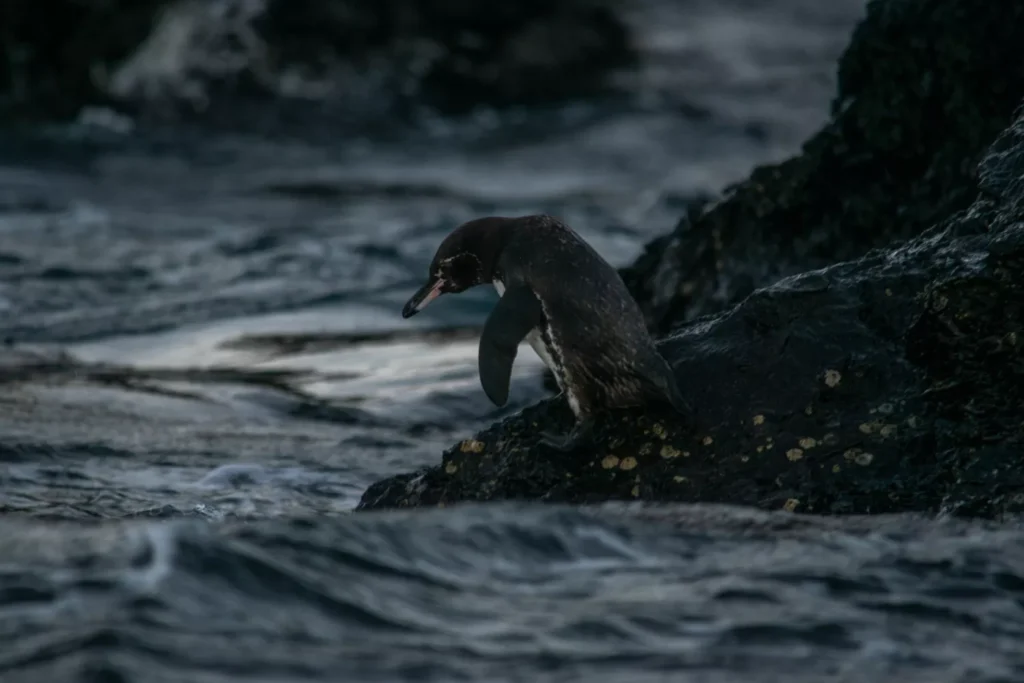
Rabida Island
Rabida Island (Jervis) is a tiny island (two square miles) located roughly three miles south of Santiago. Rabida Island is most known for its dark red sand beach surrounded by a backdrop of cliffs and steep volcanic hills full of Palo Santo trees and endemic cacti. The very distinct red fine-gravel beach is due to the iron content. Hike up a tiny peninsula for a wonderful view of the beach and the yellow saltwater lagoon. Sea caves invite exploration further down the coast.
Rabida is the only site where all nine Darwin’s finches are found.
Species found in Rabida:
On land:
- Lava lizards (endemic) – commonly seen across the island’s volcanic terrain.
- Galápagos sea lions (endemic subspecies) – often resting along the red-sand beaches.
- Opuntia cacti – native vegetation supporting local wildlife.
In the water:
- Green sea turtles – native but not endemic.
- White-tipped reef sharks – native but not endemic.
- Manta rays – native pelagic species.
- Marine fish – including parrotfish, surgeonfish, and wrasses, mostly native.
- Sea lions – often observed while snorkeling.
Birdlife:
- Darwin’s finches (endemic group) – several species present in vegetated areas.
- Swallow-tailed gulls (endemic) – nesting on coastal cliffs.
- Galápagos mockingbirds (endemic subspecies) – occasional sightings in scrub areas.
- Nazca boobies (endemic subspecies) – nesting along rocky shores.
- Red-footed boobies – native but not endemic.
- Great and magnificent frigatebirds – native but not endemic.
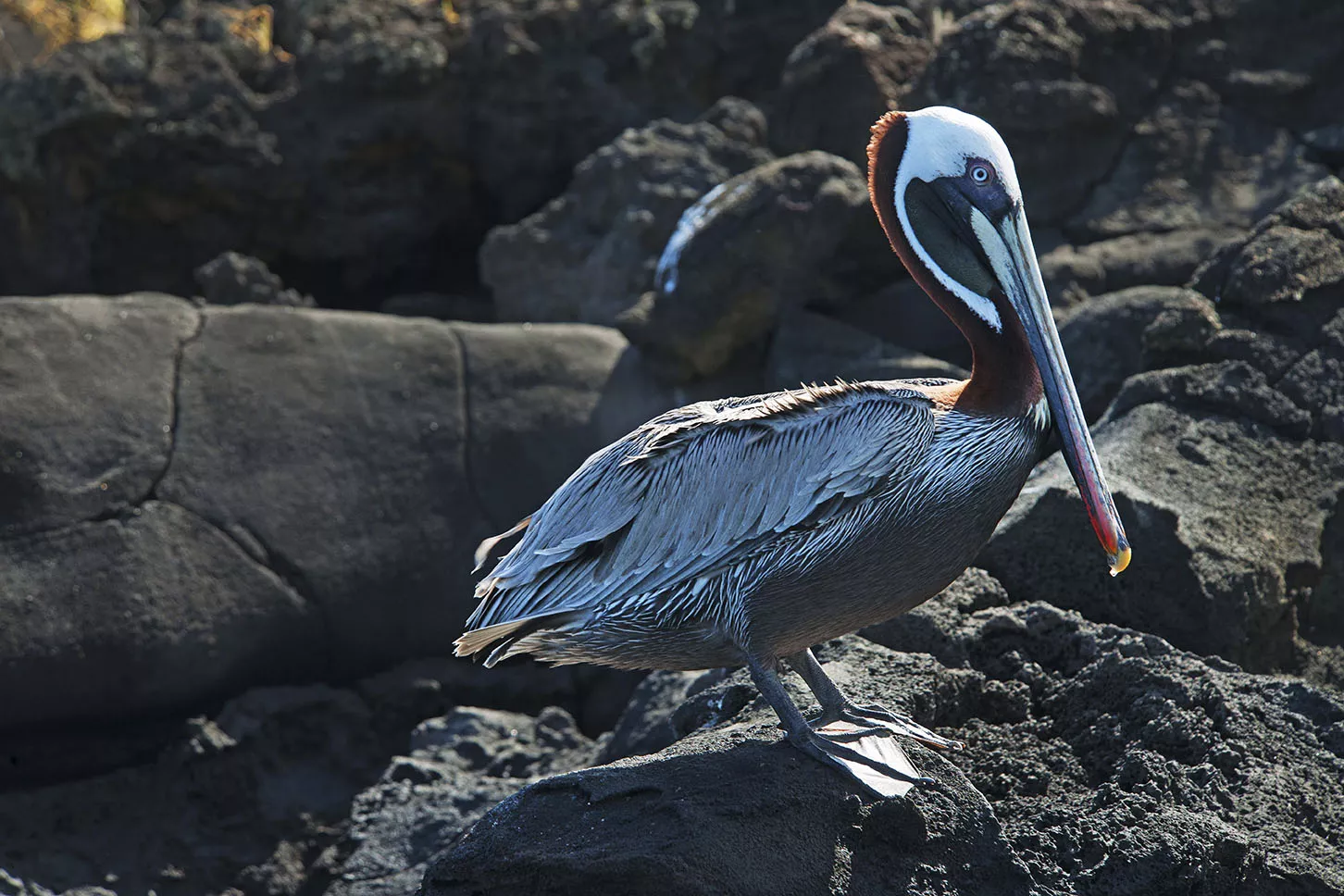
Marchena
Marchena (Blindoe) is a large island, located about 30 miles north-northeast of Santiago. The island has an unusual caldera with fascinating lava formations, as a volcanic eruption took place here in 1992. While Marchena Island is off-limits to Galapagos tourists, diving is permitted offshore.
Species found in Marchena:
In the water:
- Galápagos sea lions (endemic subspecies) – occasionally found on beaches and rocky shores.
- Galápagos sharks (endemic) – frequent around the island’s rocky reefs.
- White-tipped reef sharks – native but not endemic.
- Manta rays – native pelagic species.
- Green sea turtles – native but not endemic.
- Marine fish – including parrotfish, angelfish, and surgeonfish, mostly native.
Birdlife:
- Darwin’s finches (endemic group) – several species present in vegetated patches.
- Swallow-tailed gulls (endemic) – nesting along cliffs.
- Galápagos mockingbirds (endemic subspecies) – found in scrubby areas.
- Nazca boobies (endemic subspecies) – nesting along rocky cliffs.
- Red-footed boobies – native but not endemic.
- Great and magnificent frigatebirds – native but not endemic.
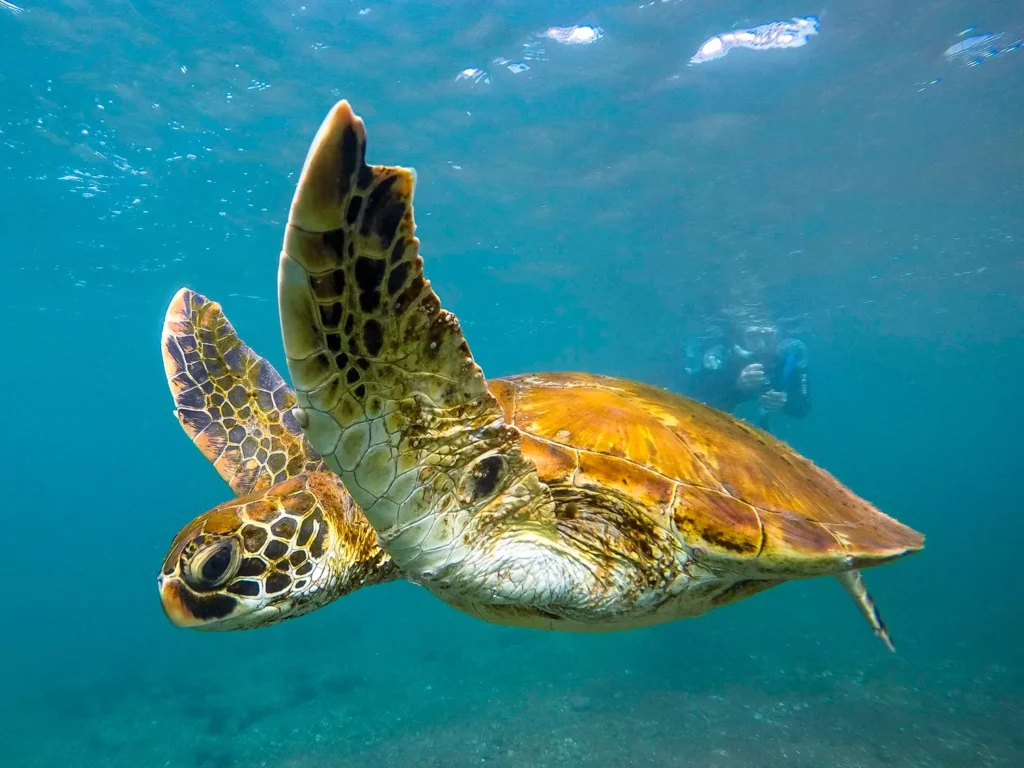
Mosquera
Mosquera is a small sandy island, located between Seymour Norte and Baltra. Mosquera island consists of a long narrow white sand beach and rocky tide pools. Unlike most islands in the archipelago, Mosquera offers visitors the rare opportunity to wander.
This is also an ideal place to swim with sea lions.
Species found in Mosquera:
On land:
- Galápagos sea lions (endemic subspecies) – the island is often crowded with sea lions resting on its narrow sandy strip.
- Lava lizards (endemic) – small reptiles found across the rocky areas.
- Opuntia cacti – minimal vegetation due to the island’s small size.
In the water:
- White-tipped reef sharks – native but not endemic.
- Manta rays – native pelagic species.
- Green sea turtles – native but not endemic.
- Marine fish – including parrotfish, surgeonfish, and wrasses, mostly native.
- Sea lions – frequently seen swimming near shore.
Birdlife:
- Darwin’s finches (endemic group) – occasionally spotted in vegetated patches.
- Swallow-tailed gulls (endemic) – nesting along rocky edges.
- Nazca boobies (endemic subspecies) – nesting along the shoreline.
- Blue-footed boobies – native but not endemic.
- Great and magnificent frigatebirds – native but not endemic.
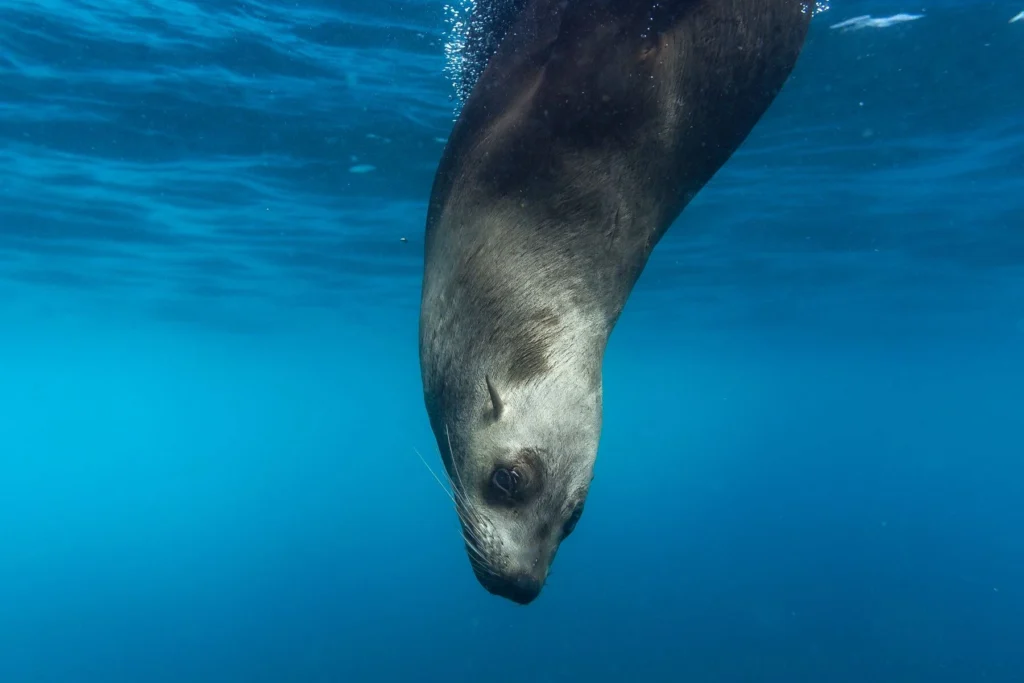
Pinta
Pinta (Abingdon) is a small, rugged volcanic island in the northern Galápagos, 25 miles northwest of Marchena. This island is famous for its role in the history of the giant Galápagos tortoises—particularly “Lonesome George,” the last known Pinta tortoise. These animals were hunted for decades by whalers and fisherman, consequentially depleting their population. Lonesome George died in June 2012 at the Darwin Research Station on Santa Cruz. Efforts to mate Lonesome George with females from similar tortoise species proved unsuccessful.
The island has steep lava cliffs and sparse vegetation, making it less hospitable for large land animals but rich in marine life around its shores.
Species found in Pinta:
On land:
- Lava lizards (endemic) – small reptiles adapted to the rocky terrain.
- Galápagos sea lions (endemic subspecies) – resting along beaches and rocky shores.
- Opuntia cacti – native vegetation supporting local wildlife.
In the water:
- Galápagos sharks (endemic) – commonly found around the island’s reefs.
- White-tipped reef sharks – native but not endemic.
- Manta rays – native pelagic species.
- Green sea turtles – native but not endemic.
- Marine fish – including parrotfish, angelfish, and surgeonfish, mostly native.
- Sea lions – often seen swimming near the shore.
Birdlife:
- Darwin’s finches (endemic group) – present in vegetated areas.
- Swallow-tailed gulls (endemic) – nesting on cliffs.
- Great and magnificent frigatebirds – native but not endemic.
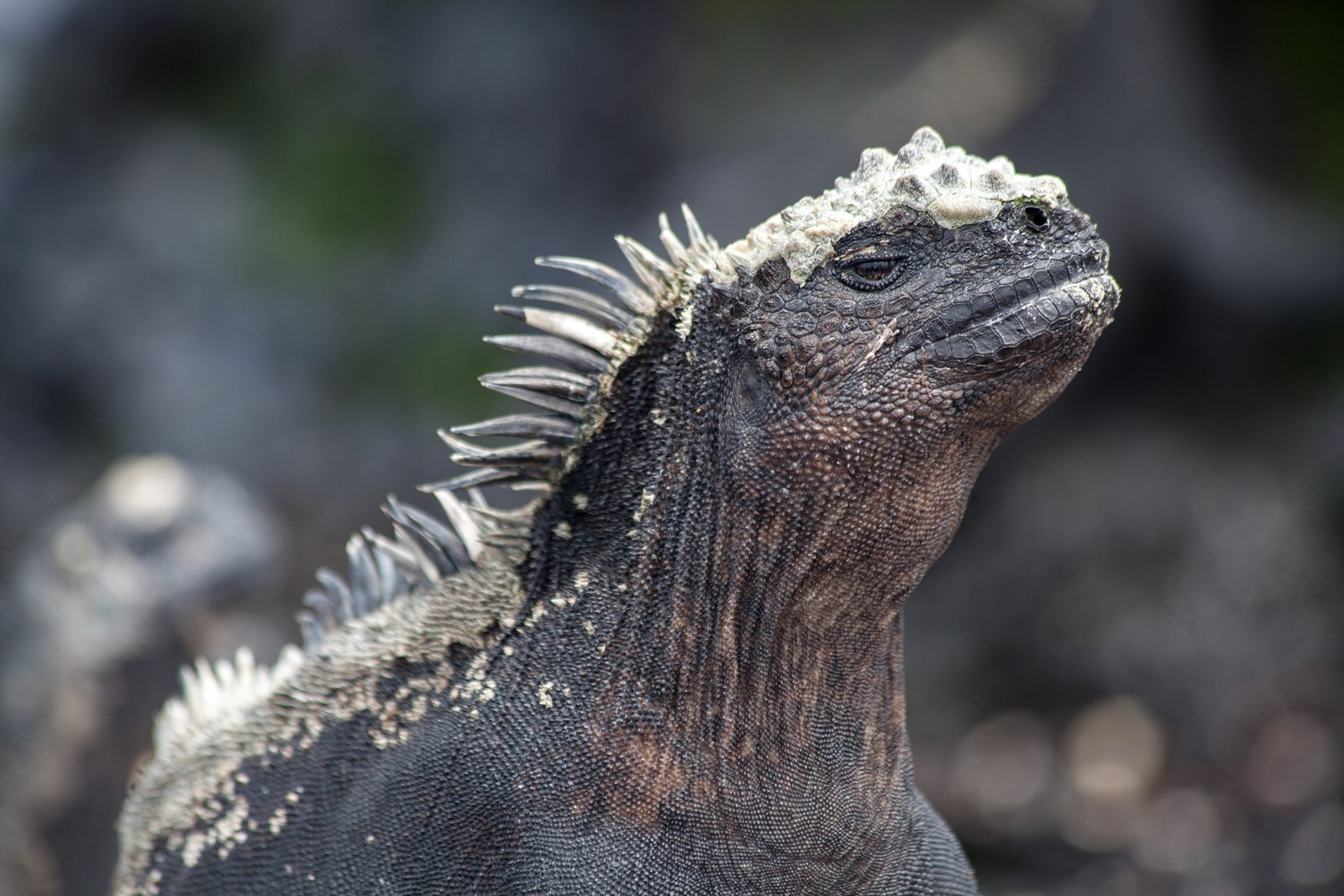
San Cristobal
San Cristobal is the fifth-largest island in the Galapagos. It is where Darwin first landed back in 1835 and where the first permanent settlements were founded. Today, the main port, Puerto Baquerizo Moreno, is the capital of Galapagos and houses many government offices, the Ecuadorian Navy, and an airport with daily flights to the mainland of Ecuador. It is also the location of Gianni Arismendy Interpretation Center. This center opened in 1998 as a phase of the project “Interpretation and Environment Education Project.” Visitors can enjoy expositions on natural history, human history, and conservation. The conservation efforts represent the movement to protect the wildlife and natural environment through means of population and tourist control.
Popular visitor sites include La Galapaguera, Punta Pitt, Isla Lobos, La Loberia, La Playa Mann, and Cerro Brujo.
Offshore you may find the popular Leon Dormido, otherwise known as Kicker Rock. This formation takes the shape of a sleeping lion. Landing is not permitted.
Species found in San Cristobal:
On land:
- Galápagos giant tortoises (endemic subspecies, Chelonoidis chathamensis) – found in highland areas.
- Galápagos marine iguanas (endemic) – basking on rocky shores.
- Lava lizards (endemic) – widespread across volcanic terrain.
- Galápagos sea lions (endemic subspecies) – resting along beaches and rocky coasts.
In the water:
- Galápagos sharks (endemic) – common around reefs.
- White-tipped reef sharks – native but not endemic.
- Manta rays – native pelagic species.
- Green sea turtles – native but not endemic.
- Marine fish – including parrotfish, angelfish, and surgeonfish, mostly native.
- Bottlenose dolphins – native but not endemic.
- Hammer-head sharks – May be seen while sciba diving at Leon Dormido.
Birdlife:
- Darwin’s finches (endemic group) – multiple species across vegetated areas.
- Swallow-tailed gulls (endemic) – nesting on coastal cliffs.
- Galápagos mockingbirds (endemic subspecies) – present in scrubby and highland areas.
- Nazca boobies (endemic subspecies) – nesting on cliffs and rocky shores.
- Red-footed boobies – native but not endemic.
- Blue-footed boobies – native but not endemic.
- Great and magnificent frigatebirds – native but not endemic.
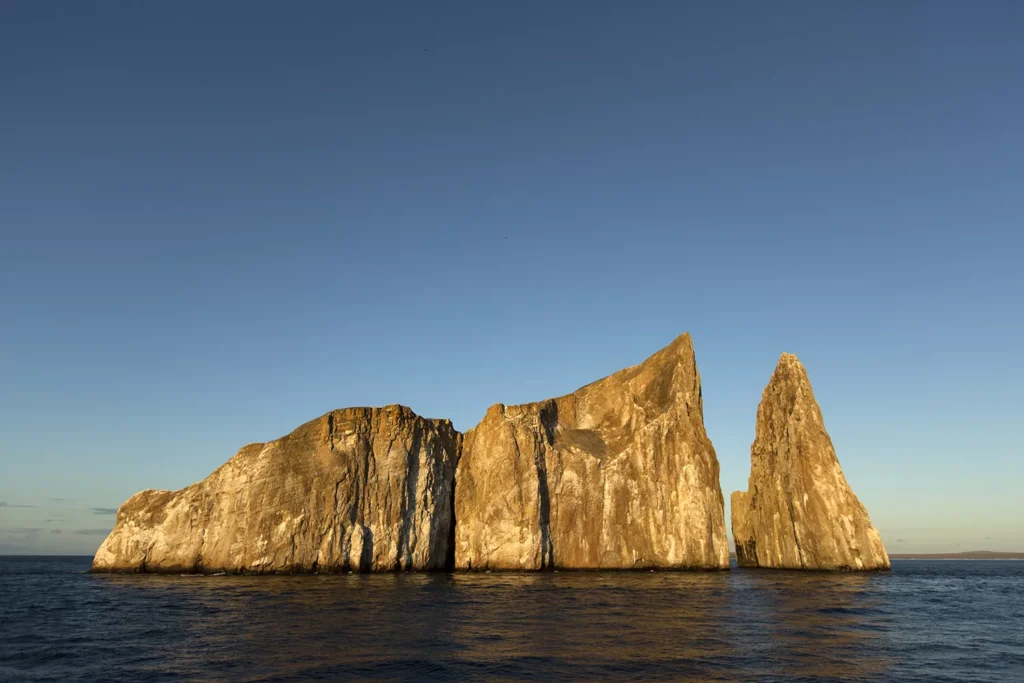
Santa Cruz
Santa Cruz (Indefatigable) is located near the center of the archipelago, and home to the largest settlement—Puerto Ayora—on Academy Bay (at the southern end). This small town offers a basic grocery store, several dive shops, restaurants, and hotels. Santa Cruz is also the main departure point for cruises.
The Charles Darwin Research Station can be found just outside of Puerto Ayora and is home to turtles ranging from three inches (new hatchlings) to four feet long. Next to it is Tortuga Bay, typically referred to as Ecuador’s most beautiful beach. The beach offers opportunities to view sea turtles, iguanas, young sharks, and rays, as well as options to hike, swim, surf, and kayak.
The highlands are located in the northern part of Santa Cruz and can reach elevations up to 5,000 feet. This area is rich with hills, ferns, volcanoes, and wildlife. The dominant vegetation in the highlands is the forest of Scalesia trees, which creates a lush green color. Giant tortoises can be observed grazing in highland pastures, while lava tubes and pits can be seen near the island’s center.
Visitor sites reachable by boat are Punta Carrion, Dragon Hill, Black Turtle Cove, and Bachas Beach.
Species found in Santa Cruz:
On land:
- Galápagos giant tortoises (endemic subspecies, Chelonoidis porteri) – found in the highlands and in semi-wild reserves.
- Galápagos marine iguanas (endemic) – seen along rocky shores.
- Lava lizards (endemic) – common throughout the island’s dry areas.
- Galápagos sea lions (endemic subspecies) – resting on beaches and piers.
- Opuntia cacti – native and widespread across arid zones.
- Manzanillo trees, Scalesia forests, and Miconia shrubs – native and endemic highland vegetation zones, each defining a distinct ecological band.
In the water:
- Galápagos sharks (endemic) – present around reefs and rocky shores.
- White-tipped reef sharks – native but not endemic.
- Manta rays – native pelagic species.
- Green sea turtles – native but not endemic.
- Marine fish – including parrotfish, surgeonfish, and wrasses, mostly native.
- Sea lions – commonly seen while snorkeling.
Birdlife:
- Darwin’s finches (endemic group) – several species inhabit various ecological zones.
- Swallow-tailed gulls (endemic) – nesting along cliffs and rocky coasts.
- Galápagos mockingbirds (endemic subspecies) – found in arid regions.
- Vermilion flycatchers (endemic subspecies) – vibrant red birds found in highland forests.
- Blue-footed boobies – native but not endemic.
- Great and magnificent frigatebirds – native but not endemic.
- Flamingoes – native but not endemic.
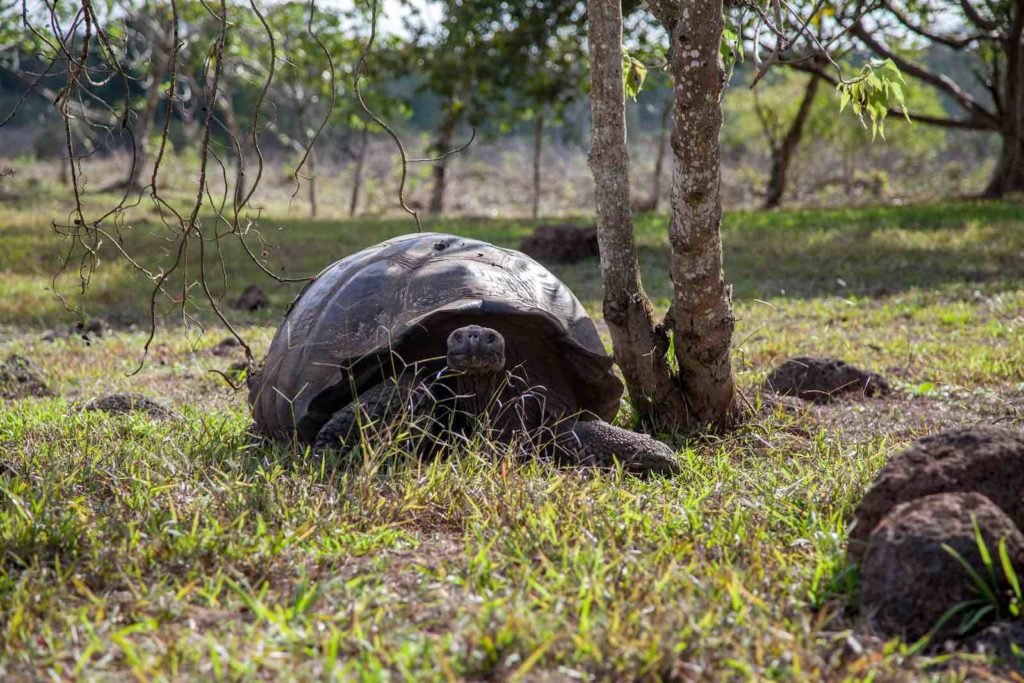
Santa Fe
Santa Fe (Barrington) is located about a dozen miles off the southeast coast of Santa Cruz and is one of the oldest islands in the Galápagos. It’s relatively small and arid and known for its unusual Palo Santo forests and Opuntia cacti. Despite its size, Santa Fe supports several species found nowhere else in the world. Here you’ll find land iguanas, lava lizards, and sea lion colonies. The island is also home to the endemic Santa Fe iguana. It is a picturesque island with two different trails, one leading to a scenic viewpoint and the other leading to a small beach. The coast offers excellent swimming and snorkeling.
Species found in Santa Fe:
On land:
- Santa Fe land iguanas (endemic species, Conolophus pallidus) – large, pale-yellow iguanas found only on this island.
- Lava lizards (endemic) – small reptiles scattered across rocky terrain.
- Galápagos sea lions (endemic subspecies) – often seen along the sandy bay and rocky shorelines.
- Santa Fe rice rat (endemic) – the only endemic rodent of the Galapagos.
- Opuntia cacti – forming tall, tree-like structures unique to this island.
- Palo Santo
In the water:
- Green sea turtles – native but not endemic.
- White-tipped reef sharks – native but not endemic.
- Manta rays – native pelagic species.
- Marine fish – including parrotfish, surgeonfish, and wrasses, mostly native.
- Sea lions – playful and abundant in the bay.
Birdlife:
- Darwin’s finches (endemic group) – several species adapted to the arid environment.
- Galápagos hawks (endemic) – often seen perched on rocks or cacti.
- Swallow-tailed gulls (endemic) – nesting along cliffs.
- Galápagos mockingbirds (endemic subspecies) – found throughout the island’s dry scrub.
- Great and magnificent frigatebirds – native but not endemic.
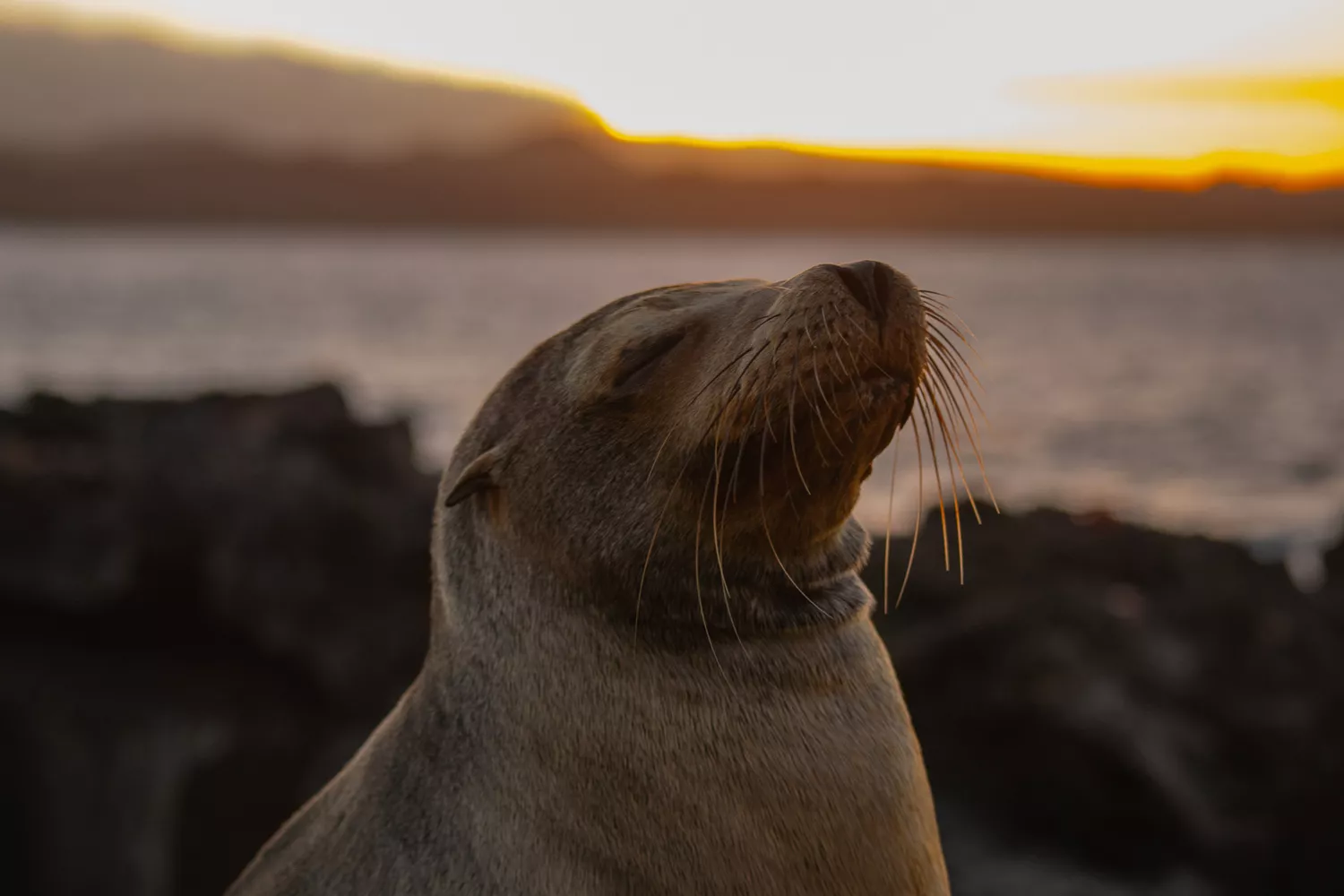
Santiago
Santiago (San Salvador or James) is a large island, located northwest of Santa Cruz, near the center of the Galápagos archipelago. This island experienced significant volcanic activity as recently as 1897. As a result, James Bay, on the west coast, features a black sand beach—home to many species of migratory birds, Darwin finches, Galapagos hawks and sea lions.
Once impacted by introduced species, Santiago has seen significant ecological recovery, making it a great place to observe both coastal and inland wildlife.
Species found in Santiago:
On land:
- Galápagos marine iguanas (endemic) – often seen sunbathing on the island’s dark lava rocks.
- Lava lizards (endemic) – darting across arid volcanic terrain.
- Galápagos land iguanas (endemic) – primarily in drier lowland areas.
- Galápagos sea lions (endemic subspecies) – commonly resting along beaches.
- Galápagos fur seals (endemic subspecies) – favoring the shaded lava grottoes along the coast.
- Opuntia cacti – native vegetation providing food and shade for reptiles and birds.
In the water:
- Galápagos sharks (endemic) – seen around rocky reefs and shorelines.
- White-tipped reef sharks – native but not endemic.
- Green sea turtles – native but not endemic.
- Manta rays – native pelagic species.
- Marine fish – including parrotfish, angelfish, and surgeonfish, mostly native.
- Sea lions and fur seals – often seen while snorkeling.
Birdlife:
- Darwin’s finches (endemic group) – multiple species in different habitats.
- Galápagos hawks (endemic) – apex predators often seen perched on lava outcrops.
- Swallow-tailed gulls (endemic) – nesting on coastal cliffs.
- Galápagos doves (endemic) – found foraging in arid areas.
- Blue-footed boobies – native but not endemic, nesting site.
- Herons and oystercatchers – native but not endemic, seen along tidal zones.
- Great and magnificent frigatebirds – native but not endemic.
- Flamingoes – native but not endemic, nesting site.
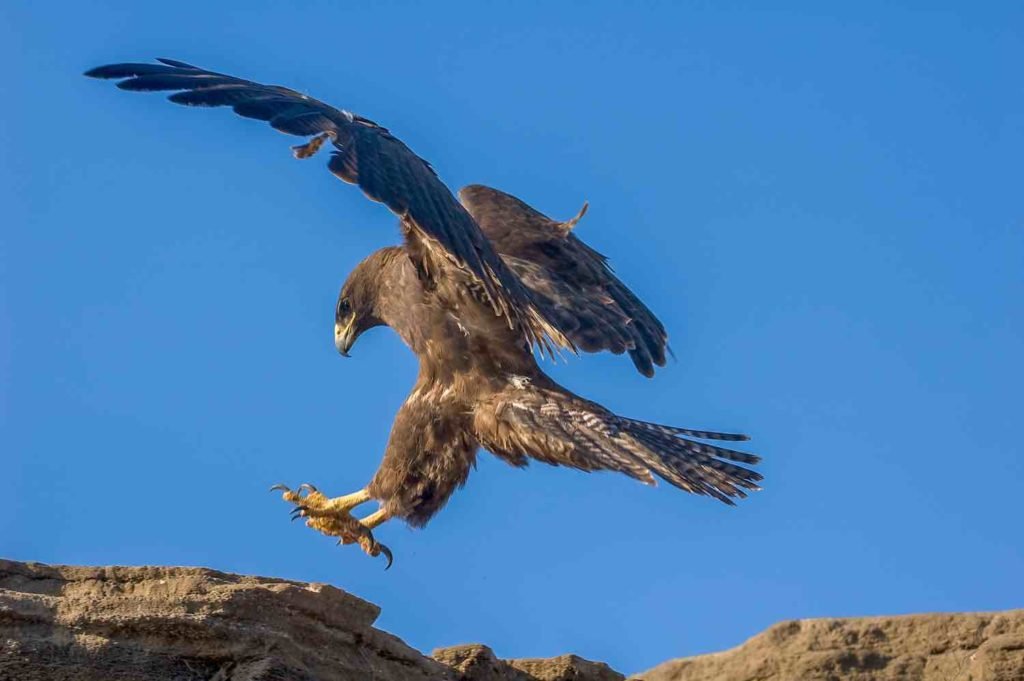
Seymour Norte
Seymour Norte (North Seymour) is a short volcanic plateau, located just north of Baltra. Created by seismic uplift, rather than volcanic origin, North Seymour is a low island composed of submarine lava. The dry landing is rich in wildlife, its rocky shore is home to sea lions, swallow-tailed gulls, and bright red and yellow Sally Lightfoot crabs. The interior is a nesting ground for Magnificent frigate birds. Blue-footed boobies and land iguanas are also common here. This area is covered in Palo Santo forest—arid during the dry season, but bright green once the rains begin. Other endemic plants include the Opuntia cactus, Croton, Castela, and Sesuvium.
Species found in North Seymour:
On land:
- Galápagos land iguanas (endemic) – restored to the island after local extinction, now thriving across the rocky terrain.
- Lava lizards (endemic) – common throughout the island.
- Galápagos sea lions (endemic subspecies) – seen resting along the shoreline and sandy areas.
- Opuntia cacti and Palo Santo trees – native dry-zone vegetation.
In the water:
- Green sea turtles – native but not endemic.
- White-tipped reef sharks – native but not endemic.
- Manta rays – native pelagic species.
- Marine fish – including parrotfish, surgeonfish, and wrasses, mostly native.
- Sea lions – playful and commonly encountered near shore.
Birdlife:
- Magnificent frigatebirds (endemic subspecies) – large breeding colonies with males displaying their bright red throat pouches.
- Great frigatebirds – native but not endemic.
- Blue-footed boobies – native but not endemic, nesting in open areas.
- Galápagos doves (endemic) – found foraging in arid areas.
- Swallow-tailed gulls (endemic) – nesting along rocky edges.
- Darwin’s finches (endemic group) – small populations found in scrubby areas.
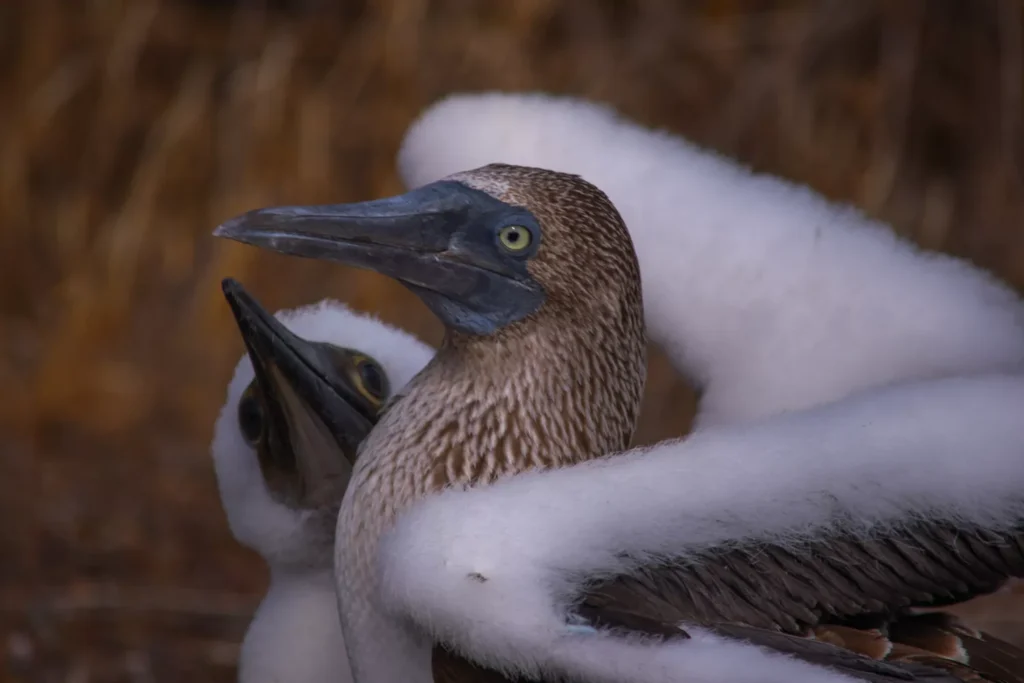
South Plaza
South Plaza is a 32-acre island, found off the east coast of Santa Cruz. This island is home to the elusive hybrid iguana, a reptile that hasn’t been found anywhere else in the Galapagos. This island is also home to a large Opuntia cactus forest, and land iguanas are usually lounging among the vegetation.
Species found in South Plaza:
On land:
- Galápagos land iguanas (endemic) – large populations, often seen basking near the cactus forests.
- Galápagos hybrid iguanas (unique to South Plaza) – natural hybrids between marine and land iguanas, displaying intermediate features.
- Lava lizards (endemic) – scattered across the rocky terrain.
- Galápagos sea lions (endemic subspecies) – resting along the rocky edges.
- Opuntia cacti – towering trees providing shade and food for land iguanas.
- Sesuvium ground cover – bright red succulents that dominate much of the terrain.
In the water:
- Green sea turtles – native but not endemic.
- White-tipped reef sharks – native but not endemic.
- Manta rays – native pelagic species.
- Marine fish – including parrotfish, surgeonfish, and wrasses, mostly native.
- Sea lions – frequently swimming near the shore.
Birdlife:
- Swallow-tailed gulls (endemic) – nesting on cliff edges.
- Darwin’s finches (endemic group) – several species present in vegetated areas.
- Great and magnificent frigatebirds – native but not endemic.
- Blue-footed boobies – native but not endemic, nesting in open areas.
- Nazca boobies (endemic subspecies)
- Red-billed tropicbirds – native but not endemic, occasionally seen flying along the cliffs.
- Galápagos mockingbirds (endemic subspecies) – found in the sparse scrub.
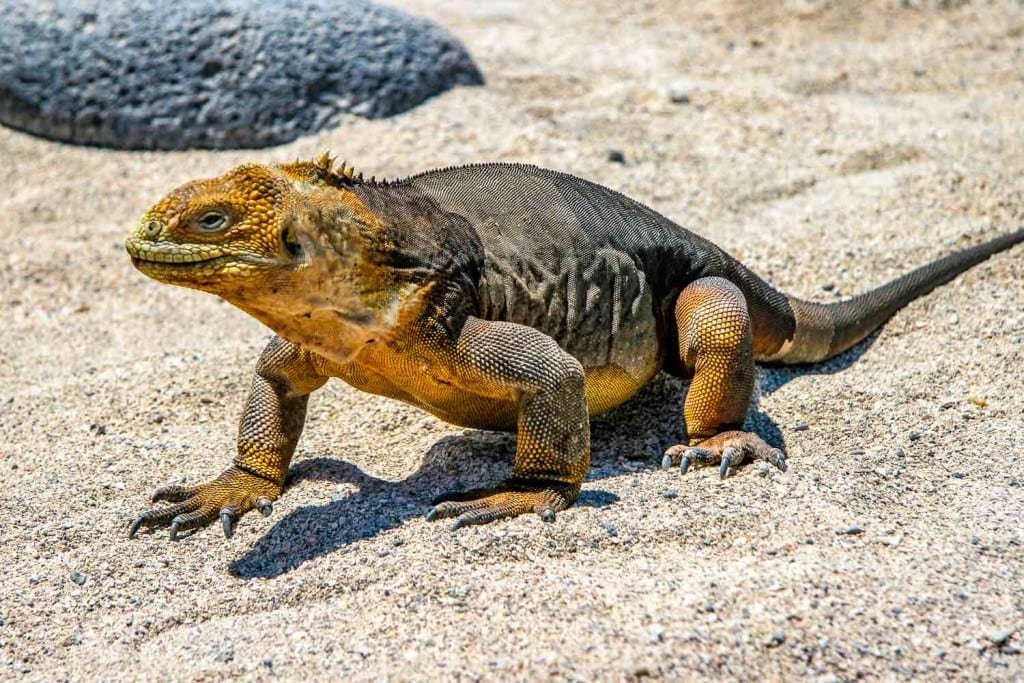
Wolf
Wolf (Wenman) is a remote islet, found to the far northwest of the island chain. Located about 22 miles southeast of Darwin, both islands are often paired together for diving itineraries. Like Darwin, Wolf Island is an eroded volcano, with a peak not much higher sea level. Wolf’s submerged caldera forms a bay with calm waters. This is an excellent location for diving and snorkeling. There is no visitor access to the island, and the steep cliffs limit terrestrial wildlife.
Species found in Wolf:
In the water:
- Scalloped hammerhead sharks (endemic subspecies) – commonly seen in large schools.
- Galápagos sharks (endemic) – frequently observed patrolling reef edges.
- Whale sharks – most visible from June to November.
- Silky sharks, blacktip sharks, and reef sharks – native but not endemic.
- Manta rays, eagle rays, and mobula rays – native pelagic species.
- Green sea turtles – native, often seen near cleaning stations.
- Tuna, barracuda, and jacks – common schooling fish.
- Bottlenose dolphins – native but not endemic.
Birdlife:
- Red-footed boobies – nest on cliffs and ledges, native but not endemic.
- Nazca boobies (endemic subspecies) – large seabirds nesting on rocky outcrops.
- Swallow-tailed gulls (endemic) – active mainly at night.
- Great and magnificent frigatebirds – native but not endemic.
- Darwin’s finches (endemic group) – a few species observed near vegetated ledges.
Let’s Start Planning Today
LANDED delivers the finest in private, tailor-made travel to Central America, South America, and the Antarctic. Speak with one of our expert travel designers today at 801.582.2100. Let us deliver the vacation of your dreams. We know the territory first-hand and by heart.



